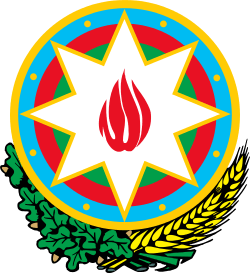Azerbaijani art
| Part of a series on |
| Azerbaijanis |
|---|
| Culture |
| Traditional areas of settlement |
| Diaspora |
| Religion |
| Language |
| Persecution |
|
Azerbaijani art has developed over the ancient history of Azerbaijan and Iranian Azerbaijan. The Azerbaijanis have created a rich and distinctive culture, a major part of which is decorative and applied art. This form of art rooted in hoary antiquity is represented by a wide range of handicrafts, such as chasing, jeweler, engraving in metal, carving in wood, stone and bone, carpet-making, lasing, pattern weaving and printing, knitting and embroidery. Each of these types of decorative art, evidence of the and endowments of the Azerbaijan nation, is very much in favor here. Many interesting facts pertaining to the development of arts and crafts in Azerbaijan were reported by numerous merchants, travelers and diplomats who had visited these places at different times.
Prehistoric art
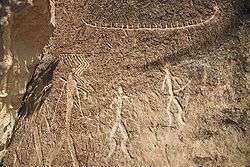
Images reflecting magic, totemic notions of ancient people, their religious customs and hunting scenes saved on rocks in Gobustan evidence about primitive art in the Paleolithic epoch. Men and women, fishing scenes, images of people dancing on the rocks, galloping horses hunters, lonely figure of a reaper with a sickle, round dances of people reminding of “yalli”, boats with rowers, solar signs and various wild animals had been portrayed there.[1]
Gamigaya Petroglyphs in the territory of Ordubad Rayon are dated back to the 4th-1st centuries BC. About 1500 dislodged and carved rock paintings with images of deer, goats, bulls, dogs, snakes, birds, fantastic beings and also people, carriages and various symbols had been found out on basalt rocks.[2]
Antiquity
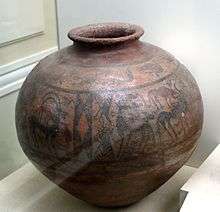
Findings of ceramic items belonged to Caucasian Albanian culture found out during archeological excavations have various shapes, perfect forms and fine ornaments. Varieties of painted ornamental and semantic motifs are typical for ceramic items found out in different oblasts of Azerbaijan such as Shahtakhty and Gizilvang.
A large vessel found out in Shahtakhty village and black-glossed zoomorphic vessels found out in Mingachevir are the most famous patterns of ceramic items of Azerbaijan. A unique rhyton cup with a figure of deer with branchy antlers on it is the most interesting find. A figure of two-headed deer from burials of Dolanlar village, bronze figures of birds from Chovdar village, gold adorning and also rhyton with deer head from Mingachevir had been found out.
Foundations of columns had been found out in different rayons of Azerbaijan, mainly from Nakhchivan and Gabala. And details of plant images had been painted on stone foundations found out in Gazakh Rayon and belonged to the 4th-3rd centuries BC. Cave dwellings of Zangilan, Gonagkend and Shamakhi Rayons, rocky shelters of Gazakh Rayon, serf and Cyclopean constructions of uplands of Lesser Caucasus and Nakhchivan found out by archeologists are also very interesting.
-

The rhyton with deer head from Mingachevir. 2nd millennium BC.
-

Stone columns from Gazakh Rayon. The 4th-3rd centuries BC.
-

The cup from Bartim village. The 2nd-4th centuries AD.
Middle Ages
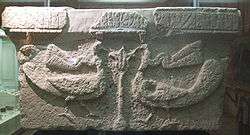
Development of old and appearance of new cities favored development of caravan trade and expansion of handicraft production. Many cities famed for rug weaving, production of artistic ceramic jars, gold and silver items.
Patterns of engravings and sculptures were broadly spread in visual arts in the period of Caucasian Albania’s existence.[3]
A stone cap of the 5th-6th centuries found out in Sudagilan settlement of Mingachevir Rayon were one of the most famous findings of that time. A cup found out in Bartim village and dated from the 2nd-4th centuries is kept in the Moscow Museum of History.
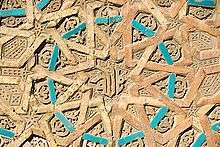
Seizure of Caucasian Albania by Arabs in the 7th century was of great importance in further development of visual arts. Muslim – Iranian and Arabic cultures began to spread in the territory of modern Azerbaijan. Construction of mosques, mausoleums, castles and other cultic architectural monuments was followed by their decoration with various patterns and ornaments, calligraphic elements (epitaph), tile and bas-reliefs. Restriction of images of alive beings by Islam stimulated development of ornamental forms of decorative arts. Ornaments on Momine Khatun Mausoleum in Nakhchivan, constructed in the epoch of the Seljuq Atabeg’ reign and khanegah on the shore of the Pirsaat River are interesting monuments of that time.
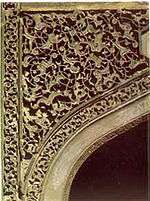
Set of small states appeared in the territory of Azerbaijan after weakening of Arab Caliphate. Local art schools were opened in cities such as Barda, Shamakhi, Beylagan, Ganja, Nakhchivan and Shabran. Architectural schools of Nakchivan, Shirvan-Absheron and Tabriz are the most important among them. Monuments and constructions of “Nakhchivan school” are distinguished for their ceramic details, which initially were one-colored, but then became multi-colored. Ornamental motifs generally consisted of baked brick and tile. Smooth stone walls with plastics which were rarely used in architectural elements, belong to “Shirvan-Absheron architectural school”. Patterns of stone carving art, geometric and plant ornaments take an important place in buildings belonging to this architectural school.
Artistic value of “divankhana” from Palace of the Shirvanshahs ensemble “are determined by perfection of the composition, tectonics of architectural forms, virtuosity of painting and creation of ornaments” according to L.Bretatsinki and B.Weymarn.
Stones with inscriptions and images of people and animals (tiger, camel, horse, bull and bird) had been found out in the Shirvanshahs’ architectural monument called Sabayil Castle constructed in the 13th century in Baku Bay.[4] There had been made in deep carving style and had characteristics of frieze. This monument is a pattern of sculptural art where inscriptions and salient images was a decisive factor in decorative design of buildings. Cultural traditions of ancient Caucasian Albania are saved in reliefs of the stones.[5]
Bayil stones which had characteristics of frieze, were consisted of decorative elements grand architectural monument located on land, at that time.
Ceramic items found out during archeological excavations in Shabran and Baylagan evidence about the high-level development of visual arts in the Middle Ages.
15th century
Azerbaijani rugs
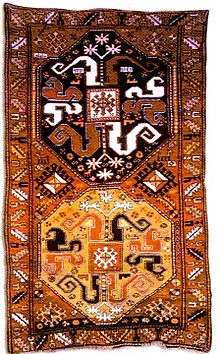
Azerbaijani rugs are a product of Azerbaijan, an ancient center of carpet weaving. Azerbaijan has been since the ancient times known as a center of a large variety of crafts. The archeological dig on the territory of Azerbaijan testifies to the well developed agriculture, stock raising, metal working, pottery and ceramics, and last but not least carpet-weaving that date as far back as to the 2nd millennium BC. Development of carpet weaving boosted after Ismail I's takeover of Safavid dynasty.
Azerbaijani carpets can be categorized under several large groups and a multitude of subgroups. The true scientific research of the Azerbaijani carpet is connected with the name of Latif Karimov, a prominent scientist and artist. It was his classification that related the four large groups of carpets with the four geographical zones of Azerbaijan, i.e. Guba-Shirvan, Ganja-Kazakh, Karabakh and Tabriz.[6]
The Karabakh carpet is one of five major regional groups of carpets made in Azerbaijan named after the Karabakh region, which comprises present Nagorno-Karabakh and adjacent lowland territories ('lowland Karabakh'). The Karabakh carpets amount to 33 compositions. Due to the specifics of the local sheep wool the Karabakh carpets are characterized by thick pile, high and fluffy. These carpets are marked for their vivid and joyous colors. They are divided into four groups: without medallions, with medallions, namazlyk and subject carpet. In the mountainous part of Karabakh the carpets were made in Malybeili, Muradkhanly, Dashbulakh, Jebrail, Goradis and many other villages.
In 2010, art of Azerbaijani carpet weaving in Azerbaijan was added to the Representative List of the Intangible Cultural Heritage of Humanity.
17th to 18th century
Tabriz school of miniature painting
Persian miniature painting was developing in the territory of Azerbaijan in the Middle Ages. Manuscripts with miniature paintings of people, animals and landscapes in them were popular at that time. Heores of poetic works by Ferdowsi, Nizami, Saadi, Hafez, Jami, Navoiy, Amir Khusrow Dehlawi and others took an important place in creativity of Persian miniature artists.[7] In the middle of the 15th century, a new style –“Turkmen style” – of miniature spread in the territories of Kara Koyunlu and Aq Qoyunlu states was developed.[3] Such miniatures of this style were made in Tabriz and other cities located in the territory of modern Azerbaijan. Shamakhi – the capital of the Shirvanshahs’ Government was one of them. Traces of this now ancient style created by artists worked in workshops of Rashidaddin in the beginning of the 14th century can be observed in miniatures created by Abdul-Bagi Bakuvi, Baku artist of the 15th century. Illustrations for “Anthology of the Eastern poetry” or “Anthology of Shamakhi” of 1468 and saved in British Museum in London are the best miniatures created by artist of Shamakhi and Baku. One-figured and two-figured portraits painted by Abdulbagi Bakuvi (“Stableman” and “Two amirs”) and saved in Topkapi Museum, in Istanbul belong to miniature art of Baku. Influence of Far Eastern painting can be felt in creativity of many miniature artists of that time.
Wars between Turkey and Iran and also feudal wrangles among khanates adversely affected development of visual arts in 17th-18th centuries. But colorful masterpieces of visual arts had been continuing created and the Palace of Shaki Khans built by architect Khadali Zeynalabdin from Shiraz in 1797, is one of these masterpieces. These decorative paintings created by masters such as Abbasgulu, Usta Gambar Garabaghi, Aligulu, Gurban Ali, Shukur and others were created with bright and motley colors. Images of people and animals, and also battle and hunting scenes were painted on the waslls of the palace.
Monumental constrictions, generally was suffering a decline. In the XVIII, wall paintings which mainly consisted of compositions of plant motifs appeared in houses of wealthy townsmen.[8] National arts created ornaments for guns and jars. A copper jar and gun found out in Lahij has highly artistic ornaments.
19th to early 20th centuries
Decorative art
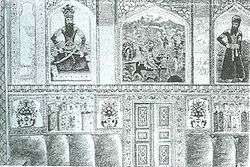

From the 19th century to early 20th century several artists of decorative arts who hadn’t got artistic education famed. Mir Mohsun Navvab who hadn’t any artistic education and also famed as a poet, music theorist and calligraphist was among the most famous artists of that time. Ornaments created by him are important in art sphere. Ornamental wall paintings, images of flowers and birds, illustrations to his own manuscripts (“Bahr-ul Khazan” (The sea of sorrow), 1864) are typical of his creativity.[9]
Usta Gambar Garabaghi used national traditions of wall-painting (1830s-1905). He famed for his works in restoration of the Palace of Shaki Khans, paintings in interiors of houses of Mehmandarov and Rustamov in Shusha and other cities. Paintings made by him didn’t break flatness of walls, but emphasized its architectural details. His new works distinguished for growth of realistic features.[10]
Landscapes, images of flowers and patterns of decorative-applied art made by poet Khurshidbanu Natavan should also be noted. She also decorated her poems with lyric art motifs.[11]
Artists such as Avazali Mughanli (“Kalila and Dimna”, 1809), Mirza Aligulu (“Shahnameh”, 1850), Najafgulu Shamakhili (“Yusuf and Zulaikha”, 1887) and others were famed among Azerbaijani miniature painters of that time.
Easel painting
New progressive visual arts of Azerbaijan faced a delay in development in the 19th century. Development of realistic easel painting was extremely low.[9]
Origination of easel painting in Azerbaijani visual arts began in this period, but works of that period such as portraits painted in Irevan “were still firmly connected to traditions of the eastern miniature of middle ages”.[10]
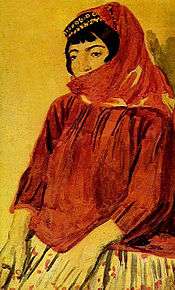
A painter Mirza Gadim Iravani, who also hadn’t got professional artistic education mainly famed as a portrait artist. “Dancer”, “Dervish”, “Strongman” and “Cavalryman” are his most popular works. His works are saved in National Art Museum of Azerbaijan. Portrait of a young man, portrait of a sitting woman and others are among these works. Irevani, whose works were firmly connected to traditions of the eastern miniature of medieval ages, laid down the foundations of the realistic easel painting in Azerbaijan.[9] Paintings in Sardar’s Palace in Irevan and also portraits of “Fath Ali Shah”, “Abbas Mirza”, “Mah Talat khanim” and “Vajullah Mirza” are among famous works of Mirza Gadim Iravani. Beside these portraits he also painted a portrait of “Unknown warrior”.[9] The palace was demolished in 1914 and four great portraits on the walls of the palace and also paintings on the walls of houses in Shusha were also erased.[9]
“Timur’s portrait” by Mir Mohsun Navvab painted with watercolors in 1902 and now saved in National Art Museum of Azerbaijan in Baku is also famous.
Genres of satiric graphics were appeared with publishing of “Molla Nasraddin” magazine in the beginning of the 20th century and development of book publishing. Artists of the magazine such as O.Schemrling, I.Rotter, A.Azimzade and K.Musayev actively worked in this sphere of arts. Azim Azimzade is a founder of satiric graphics of Azerbaijan.[12] His sharp caricatures and grotesques scoffing at social inequality, ignorance, fanaticism and oppression by Tsarism are also famous. His series of watercalar paintings called “Hundred types” dedicated to freedom of women, atheism and political motifs and also illustrations to Mirza Alakbar Sabir’s “Hophopname” collection of works are famous.
Bahruz Kangarli is the first Azerbaijani artist who got incomplete professional education (1926), being one of the founders of realistic easel arts of Azerbaijan, created landscapes such as “Ilanly Mountain under the moonlight”, “Before the dawn” and “Spring”. He also created portraits of unfortunate people in “Refugees” series and everyday life compositions “Matchmaking” and “Wedding”. His album “Memory of Nakchivan” consistsing of twenty landscapes is saved in National Art Museum of Azerbaijan.
Kangarli drew outlines of costumes for “Deadmen” (J.Mammadguluzadeh), “Haji Gara” (M.F.Akhundov), “Peri Jaud” (A.Hagverdiyev) and other plays staged in Nakhchivan, in 1910.
-

"Shore". Khurshidbanu Natavan. 1886.
-
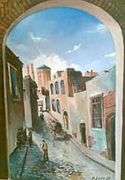
Landscape from "Memory of Nakhchivan" album. Bahruz Kangarli. The early 20th century.
-

"Portrait of Shaikh ul Islam". Ali bey Huseynzade. The early 20th century.
-

"Cock fight". Azim Azimzade, 1915.
20th century
Azerbaijan Democratic Republic
Independence Museum of Azerbaijan, where national attributes of Azerbaijan – the state coat-of-arms and flag- were created, was founded in Baku, in 1919, after establishment of Azerbaijan Democratic Republic. Meetings dedicated to protection and restoration of historical monuments were held in the museum. At that time “Fuyuzat” magazine was issued by Ali bey Huseynzade, the eminent philosopher, journalist and artist of that time and founder of oil painting arts in Azerbaijan.[13] “Bibi-Heybat Mosque” and “The portrait of Shaikh ul islam” are his famous works.[13]
Soviet Azerbaijan
New type of arts was forming in Azerbaijan after establishment of the Soviet regime in Azerbaijan, in 1920. The first art school where new genres of visual arts were created, was opened in 1920, in Baku.[14]

In 1930s, artists such as Azim Azimzade, Farhad Khalilov, H.Khaligov, I.Akhundov, A.Hajiyev, M.A.Vlasov, K.Kazimzade, A.Mammadov and others worked in the sphere of graphics. Illustrations to books of Azerbaijani and foreign writers were made. Placards to actual themes of that time were also made.
In 1928, the first art exhibition of Azerbaijani Union of Young Artists was held. In 1930s, exhibition of Azerbaijani Union of Revolutionary Visual Arts achieved a great success.
In 1932, the Committee of Azerbaijani Artists was created. In that period, works such as “Grape harvesting” by S.Sharifzade, “Azim Azimzade’s portrait” by H.Hagverdiyev and “Portrait of Nizami Ganjavi” by Gazanfar Khaligov, were famous. Works by Mikayil Abdullayev, B.Mirzazade, B.Aliyeva, Sattar Bahlulzade and K.Khanlarova should also be mentioned. The first congress of Azerbaijani artists was held in 1940.
Generally, political placards and satiric caricatures were made during World War II. Well-known artists as H.Khaligov, I.Akhundov, A.Hajiyev and S.Sharifzade were authors of such politic placards.

Maturity stage in Azerbaijani visual arts began in the mid 1950s. Mikayil Abdullayev, Tahir Salahov, Vidadi Narimanbekov, Sattar Bahlulzade, Togrul Narimanbekov, Geysar Kashiyeva and others were famous artists of the Soviet Azerbaijan, in the second half of the 20th century.[15][16] Tahir Salahov credited for pioneering a version of “severe realism” more truthful to the grim realities of workers’ lives than the bright certainties of Socialist Realism.[17]
B.Aliyev, I.Feyzullayev, A.Mammadov, A.Verdiyev and others portrayed subjects of labor and industry in their works. But the works of Elbey Rzaguliyev, T.Sadighzade, Arif Huseynov, K.Najafzade and others are dedicated to historic past, traditions and customs of Azerbaijani people, to war and peace. J.Mirjavadova, N.Rahmanova, K.Ahmadova, G.Yunusova, S.Veysova, A.Ibrahimova, I.Mammadova, S.Mirzazade, F.Hashimova, F.Gulamova, A.Samadova and others painted mythological images.
Maral Rahmanzade was the first Azerbaijani woman artist who got professional artistic education achieved a great success in the sphere of easel painting and book illustration.
21st century
Independent Azerbaijan
After Dissolution of the Soviet Union, organisations such as "YARAT" created to nurture an understanding of contemporary art in Azerbaijan and to creating a platform for Azerbaijani art, both nationally and internationally.[18][19]
Maiden Tower International Art Festival has been organized since 2010 with the view of the global promotion of the Maiden Tower in Old City of Baku, included in UNESCO’s World Heritage List in 2000 and considered the symbol of Baku.[20] In 2012, Azerbaijan staged the 012 Baku Public Art Festival, country's first modern art festival.[21]
As of 2000s, Fine-art photography became popular in Azerbaijan, with names such as Rena Effendi hosting exhibitions in London and New York City.[17]
Azerbaijani and Western Art museums of Azerbaijan
- Azerbaijan Carpet Museum
- Azim Azimzade's House Museum
- Bahruz Kangarli's House Museum
- Baku Museum of Miniature Books
- Baku Museum of Modern Art
- Gobustan National Park
- National Art Museum of Azerbaijan
- Nakhchivan Open-air Museum
- Sattar Bahlulzade's House Museum
See also
References
- ↑ UNESCO World Heritage: Gobustan Rock Art Cultural Landscape
- ↑ Наскальные рисунки Гямигая
- 1 2 3 Л. С. Бретаницкий, Б. В. Веймарн. Очерки истории и теории изобразительных искусств. Искусство Азербайджана
- ↑ Художественная энциклопедия
- ↑ Академия художеств СССР. Институт теории и истории изобразительных искусств. Всеобщая история искусств. Том 2. Искусство средних веков. Книга вторая. Искусство Ближнего и Среднего Востока. Искусство Азербайджана
- ↑ "Art - KMT". www.kmt.az. Archived from the original on 3 March 2016. Retrieved 6 November 2014.
- ↑ G.Fehervari. Art and architecture // Peter Malcolm Holt, Ann K. S. Lambton, Bernard Lewis. The Cambridge history of Islam, vol. 2. Cambridge University Press, 1977. ISBN 0-521-29138-0, 9780521291385. Стр. 738 "In miniature painting, Herat remained the centre only for a few years after Shah Ismail's occupation of the city. Artists, like Bihzad and many of his pupils, moved to the new capital, Tabriz. Thus Tabriz became once more a centre of Persian painting. Another new centre emerged in Bukhara, which was very active during the tenth/sixteenth and early eleventh/seventeenth centuries. Illumination of manuscripts of the Shah-namа and Khamsa of Nizami continued. Bihzad's style was followed for quite a long time. Upon the moving of the capital to Isfahan under Shah 'Abbas I, a new school of painters was founded there which excelled not only in miniature painting, but also in the production of bookbindings and in lacquer-works as well."
- ↑ Л.С. Бретаницкий. "Архитектура и изобразительное искусство.". Российские универсальные энциклопедии. Брокгауз-Ефрон и Большая советская энциклопедия объединенный словник. Archived from the original on 2012-04-11.
- 1 2 3 4 5 Гюнай Джафарова. Творчество М. К. Эривани нашедшее отражение в исследованиях К.Керимова.
- 1 2 Под общ. ред. Б.В. Веймарна, Ю.Д. Колпинског (1964). Всеобщая история искусств. 5. Moscow: Искусство.
- ↑ Живопись Азербайджана Archived October 26, 2014, at the Wayback Machine.
- ↑ Азимзаде Азим Аслан оглы в Большой советской энциклопедии
- 1 2 Jonathan M. Bloom, Sheila Blair. (2009). The Grove Encyclopedia of Islamic Art and Architecture. 2. Oxford University Press. p. 513. ISBN 9780195309911.
- ↑ Изобразительное искусство в XIX — первой половине XX века
- ↑ "Azerbaijani Artists". www.arthistoryarchive.com. Retrieved 6 November 2014.
- ↑ История живописи Азербайджана. www.azerbaijans.com (in Russian). Retrieved 6 November 2014.
- 1 2 Crichton-Miller, Emma. "Azeri Artists Take on the World". www.nytimes.com. Retrieved 6 November 2014.
- ↑ "YARAT Contemporary Art Organisation". artdubai.ae. Retrieved 6 November 2014.
- ↑ Gleadell, Colin. "Art market: Azerbaijan in the spotlight". www.telegraph.co.uk. Retrieved 6 November 2014.
- ↑ "Maiden Tower International Art Festival". www.heydar-aliyev-foundation.org. Retrieved 6 November 2014.
- ↑ Michalska, Julia. "Azerbaijan stages first art festival". www.theartnewspaper.com. Retrieved 6 November 2014.

